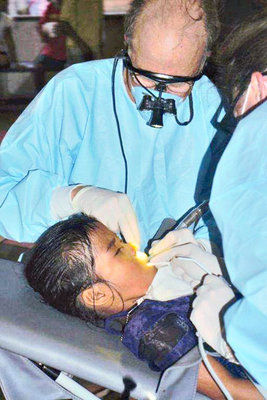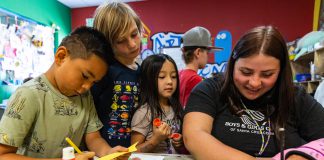
Living in the United States, it can be easy for people to take for granted something as simple as brushing your teeth.
For many residents of the tiny island nation of Micronesia, however, access to dental care is something so rare that many don’t even own toothbrushes, according to a local dentist who took his skills overseas on an oral hygiene mission.
As part of the Micronesia Dental Support Project, Ben Lomond dentist Bill Anderson, accompanied by his wife, Linda, and longtime dental assistant Denise Dix, spent six days in June visiting the island nation and providing dental care and education to those in need.
The trio joined 17 others, including two other dentists, in schools and community centers around the Chuuk Lagoon, where they treated what Anderson described as cases of extensive tooth decay.
“Of all the work I’ve done with underserved people, I’ve never seen so much dental disease,” said Anderson, who has also treated patients in northernMexico.
Andersonsaid the rampant tooth problems he saw among the Micronesian people were partially the fault of replacing the region’s traditional seafood-based diet with processed and sugar-laden Western-style food.
“The people ofMicronesiahave been ruled by other countries for a very long time,” he said. “There’s been a dietary shift as the industrialized world has descended on them.”
One of the worst causes of the extensive tooth decay Anderson saw was from betel nuts — an acorn-like nut that the locals shell, wrap with tobacco and coral dust, and chew. The abrasive coral dust badly damages their teeth, he said.
“I probably extracted at least 80 teeth,” he said.
Anderson’s group treated patients six hours daily for four days in four different locations.
“We tried to treat children first,” he said. “There might be 50 to 100 people per day needing treatment.”
Because of the extent of the need, Anderson said, the three dentists were forced to treat for pain more often than not — usually by extraction.
“The amount of decay people had was extensive,” he said. “I had to extract adult teeth on children who were under 10 years old.”
One patient in particular stood out,Andersonsaid.
“One young girl, of about 14, came alone with tooth pain under one of her adult molars,” he said. “It had an abscess under it the size of a grape.”
The group hosted several teaching sessions to inform people about dental hygiene and ways to keep their teeth healthy.
The biggest challenge,Andersonsaid, was getting from place to place, as long boat rides were often the only way to travel between islands. A planned visit to an outlying island had to be canceled because the airstrip was too beat up for a safe landing.
“There’s a very loose infrastructure,” he said. “There’s a lot of unmet needs there — it’s not an easy thing to have a program like this in such a remote area.”
Andersonsaid that the entire group felt immediately welcomed and that the patients were eager to receive treatment and learn proper dental techniques.
“The people there are very friendly — they were great patients, and we were very well received,” he said.
Andersonsaid he was particularly grateful that his wife and Dix were able to accompany him toMicronesia.
“To share this experience with them was a wonderful experience,” he said.
He said the culture of the San LorenzoValley, where he has practiced dentistry for 36 years, played a big factor in his decision to participate.
“We live in a special place, where people take care of each other and look out for each other,” he said. “It makes it easy to get involved on a local level.
“I look at my trip toMicronesiaas an extension of that.”
For information: http://mdsp.unitedcp.org












